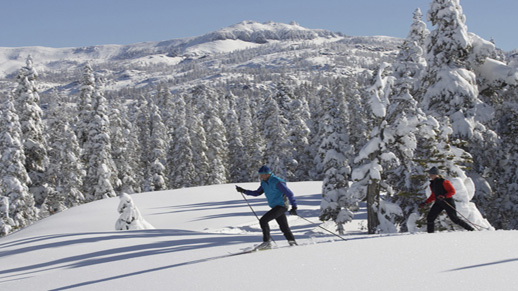Ahh, the dream of taking a winter to go and work as a ski bum. Working at a ski resort has a lot of allure, not the least of which is nearly daily skiing or snowboarding (if you want it). And who doesn’t want to wake up in a great mountain town every morning.
Makes it temping to start packing your bags and looking for ski resort jobs.
Working at a ski resort can be a pretty neat experience, but go in with your eyes open. Here are a few things to know about working as a ski bum or at a ski resort for the winter.
Things to Know About Working at a Ski Resort
Pay is Low; Benefits are in the Lifestyle
You won’t make a ton of money working at a ski resort. Pay is hourly, and not super high unless you have a job that requires experience or certification. At smaller ski areas, you might be making not much more than minimum wage — perhaps $11 to $15 an hour. For more skilled jobs like a lift operator, you might make a little more. Out West or in higher-cost areas, that wage might bump up closer to $18 or $20.
smaller ski areas, you might be making not much more than minimum wage — perhaps $11 to $15 an hour. For more skilled jobs like a lift operator, you might make a little more. Out West or in higher-cost areas, that wage might bump up closer to $18 or $20.
Ski instructors might be able to make some tips in addition to their wage. Keep in mind that as an instructor, you only work when a lesson is booked. For many, that might mean just 4-hours a day on some days.
Don’t let the pay deter you, though. The goal of working at a ski resort is not to get rich, it is to experience a winter full of snow. Further down, we will talk about the perks.
You Might Need to be Certified
Some jobs will require certification. If you can get one, you may get paid more.
Ski patrol need to be certified. The National Ski Patrol (NSP) has a certification that ski patrols get. You can also be a ski patrol with an EMT licensure. When you are dealing with injuries, avalanche risks, or lost skiers, it is important to know what you are doing.
Ski instructors also need certification from the International Ski Instructor Association (ISIA). There are 4 levels of certification, which have much more to do with the training you get than how good a skier you are. Level 1 is the lowest, and with each successive level, more training is required. Typically, pay increases with Level, and you also get to teach more advanced skiers.
For other jobs, such as grooming or a lift mechanic, experience is a must even if certification is not required.
You Will be Able to Ski A Lot!
Let’s not hide the lead here: You will probably get a free season pass.
That means you will be able to ski as much as you want, when you want, when you are not working. There are some exceptions if you are very part time, but for most ski resorts, free skiing (for you, and possibly a spouse or dependent) is part of the deal.
Working at a ski resort will change the way you ski. Many of the work shifts are part days, or at least not from 9am to 4pm as you will change shifts midday. This means that many people who work at ski areas get 2-3 hours of skiing every single day…. or at least every day they want to ski.
For many in the mountains, that means you will get 10,000 vertical feet of skiing or boarding in on a regular basis. Plus, when you have an off day, there is nothing to stop you from skiing all day.
Perhaps best part is that through your work network, you will quickly learn where to ski every day. You will know that nice little patch of powder that normally doesn’t get touched until lunchtime, and you will have a good idea where the good snow will be based on the winds the prior night.
Housing Can Be an Issue
Well-documented as of late are the problems with employee housing in expensive ski towns. Places like Aspen, Vail, Steamboat, Big Sky, Tahoe — you name it — have trouble finding good places for lower-paid ski resort employees to live during the ski season. Real estate prices have shot up because of people buying ski homes, and limited new supply because of geographical constraints. Vail isn’t Dallas – you can’t just keep building out and out.
Expect to do one of two things: Either find a lot of roommates for a place nearby, or stay in a larger town that requires a commute to the ski town.
There are exceptions, of course. Some ski resorts are including with their new developments more employee housing. Others are in places, like Salt Lake City, where the nearby housing stock is actually pretty good.
But go in with your eyes open regarding the housing situation. You may want to actually figure that out before you accept a job offer.
Other Discounts are a Perk
In addition to what will very likely be free skiing all winter, expect other perks too. 
You might get discounts at other ski areas that have deals with your employer. It is common to see discounts of 25% to 50% for skiing at “partner” ski areas in those off days when you want to explore a little.
Food is notoriously expensive at ski resorts, and as an employee you can expect discounts of 25% to 50%. That makes what would have been an outrageous bowl of chili one that is merely market price — not a bad deal if you are doing it every day.
In addition to food, you will probably get discounts on “hard goods” such as ski equipment or clothing, assuming you buy it through the resort-owned shops. A typical discount on hard goods is something like 20%.
They Need Help in the Summer, Too
A common misperception of ski resorts is that they only hire in winter. Go by Vail or Big Sky or Park City in the summer, and you will notice that it is buzzing year-round.
If you are up for helping out at a ski resort in summer, you probably will quickly have a job. The good news is that housing will likely be a little easier to find and cheaper.
Ticket windows (for mountain bikers and hikers), maintenance, kids clubs, and food service are all in high-demand at most ski areas from June through September. The off-months tend to be late April, May, October, and November.

Paul Miller is the Founder of Family Skier. He is an advanced skier and has extensive experience with family travel and ski schools. An accomplished skier, he has skied in 15 states and provinces and 6 countries. In addition to FamilySkier, his writing can be found on many ski-related websites, and as curriculum for many ski clubs in North America.




